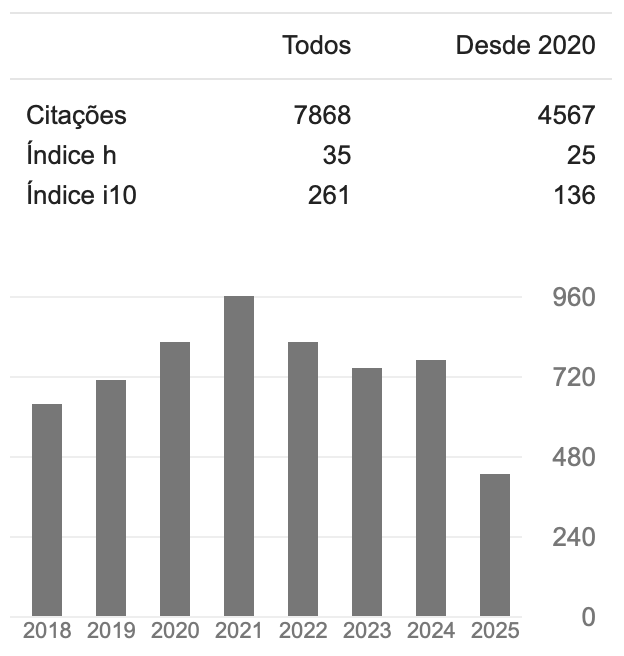Efeito do treinamento aeróbico na modulação autonômica, composição corporal, capacidade funcional e pressão arterial interdialítica 24 horas
Effect of aerobic training on autonomic modulation, body composition, functional capacity and 24-hour interdialytic blood pressure
DOI:
https://doi.org/10.17765/2176-9206.2024v17n1.e12377Palavras-chave:
Exercício, Hemodiálise, Modulação autonômica, Pressão arterialResumo
O objetivo foi analisar o efeito do treinamento aeróbico sobre a modulação autonômica, capacidade funcional, composição corporal e pressão arterial de 24 horas interdiálise. Trata-se de um estudo transversal de intervenção, incluindo 28 pacientes em hemodiálise, divididos em dois grupos: (Exercício, n = 13; Controle n = 15), submetidos a um programa de exercício aeróbico durante 12 semanas. Foram avaliados a Variabilidade da Frequência Cardíaca, Teste de caminhada de 6 minutos (TC6), Pressão arterial de 24 horas interdiálise, e marcadores bioquímicos antes e após o programa de exercício. Pós treinamento de 12 semanas com exercício aeróbico o grupo Exercício apresentou redução no número de batimentos cardíacos em comparação ao grupo Controle (69.86 ± 7.53 vs 74.71 ± 3.3), respectivamente. Além disso, no grupo Exercício, houve diminuição do componente simpático, visto pelo índice 0V (%) (pré 24.85 ± 8.99 vs pós 16.2 ± 12), e incremento no índice parassimpático, observado através de 2V (%) (pré 29.1 ± 5 vs pós 43.5 ± 5). Mais ainda, maior distância no TC6 (pré 489 ± 81 vs pós 607 ± 84), menor pressão arterial de 24 horas interdialítico, e melhora nos marcadores bioquímicos no momento pós em comparação ao grupo controle. Diante disso, após 12 semanas de treinamento aeróbio com intensidade moderada houve melhora nos parâmetros de risco cardiovascular, como modulação autonômica, TC6, pressão arterial sistólica e perfil lipídico nestes pacientes renais crônicos avançado que realizam hemodiálise.Downloads
Referências
Webster AC, Nagler EV, Morton RL, Masson P. Chronic kidney disease. Lancet. 2017. https://doi.org/10.1016/S0140-6736(16)32064-5.
Romagnani P, Remuzzi G, Glassock R, et al. Chronic kidney disease. Nat Rev Dis Primers. 2017. https://doi.org/10.1038/nrdp.2017.88.
KDOQI. Ctilinical Practice Guidlines. Natl Kidney Found KDOQI [Internet]. 2002;(ISBN: 978-602018809-0-6):126–35. Available from: http://jurnal.unimus.ac.id.
Hill NR, Fatoba ST, Oke JL, et al. Global prevalence of chronic kidney disease: a systematic review and meta-analysis. PLoS One. 2016. https://doi.org/10.1371/journal.pone.0158765.
Bello AK, Levin A, Lunney M, et al. Status of care for end stage kidney disease in countries and regions worldwide: international cross sectional survey. BMJ. 2019. https://doi.org/10.1136/bmj.l5873.
Neves PDM, Sesso RCC, Thomé FS, et al. Censo brasileiro de diálise: análise de dados da década 2009-2018. Braz J Nephrol. 2020. https://doi.org/10.1590/2175-8239-JBN-2019-0234.
Chan CT, Blankestijn PJ, Dember LM, et al. Dialysis initiation, modality choice, access, and prescription: conclusions from a Kidney Disease: Improving Global Outcomes (KDIGO) Controversies Conference. Kidney Int. 2019. https://doi.org/10.1016/j.kint.2019.01.017.
GBD Chronic Kidney Disease Collaboration. Global, regional, and national burden of chronic kidney disease, 1990-2017: a systematic analysis for the Global Burden of Disease Study 2017. Lancet. 2020. https://doi.org/10.1016/S0140-6736(20)30045-3.
Sesso RCC, Lopes AA, Thomé FS, et al. Censo brasileiro de diálise, 2009. J Bras Nefrol. 2010. https://doi.org/10.1590/S0101-28002010000400007.
Burgess ED. Cardiac vagal denervation in hemodialysis patients. Nephron. 1982. https://doi.org/10.1159/000182466.
Johansson M, Gao SA, Friberg P, Annerstedt M, Bergström G, Carlström J, et al. Reduced baroreflex effectiveness index in hypertensive patients with chronic renal failure. Am J Hypertens. 2005. https://doi.org/10.1016/j.amjhyper.2005.02.002.
Tamura K, Tsuji H, Nishiue T, Yajima I, Higashi T, Iwasaka T. Determinants of heart rate variability in chronic hemodialysis patients. Am J Kidney Dis. 1998. https://doi.org/10.1053/ajkd.1998.v31.pm9531175.
Celik A, Melek M, Yuksel S, Onrat E, Avsar A. Cardiac autonomic dysfunction in hemodialysis patients: The value of heart rate turbulence. Hemodial Int. 2011. https://doi.org/10.1111/j.1542-4758.2011.00529.x.
Mustata S, Chan C, Lai V, Miller JA. Impact of an exercise program on arterial stiffness and insulin resistance in hemodialysis patients. J Am Soc Nephrol. 2004. https://doi.org/10.1097/01.ASN.0000140256.21892.89.
Hull SS, Vanoli E, Adamson PB, Verrier RL, Foreman RD, Schwartz PJ. Exercise training confers anticipatory protection from sudden death during acute myocardial ischemia. Circulation. 1994. https://doi.org/10.1161/01.cir.89.2.548.
Carreira MAMQ, Nogueira AB, Pena FM, Kiuchi MG, Rodrigues RC, Rodrigues RR, et al. Detection of autonomic dysfunction in hemodialysis patients using the exercise treadmill test: The role of the chronotropic index, heart rate recovery, and R-R variability. PLoS One. 2015. https://doi.org/10.1371/journal.pone.0128123.
Siragy HM, Carey RM. Role of the intrarenal renin-angiotensin-aldosterone system in chronic kidney disease. American Journal of Nephrology. 2010. https://doi.org/10.1159/000313363.
Deligiannis A, Kouidi E, Tassoulas E, Gigis P, Tourkantonis A, Coats A. Cardiac effects of exercise rehabilitation in hemodialysis patients. Int J Cardiol. 1999. https://doi.org/10.1016/s0167-5273(99)00090-x.
Javera VBM, Salado GA. Orientações Nutricionais para pacientes em Programa de hemodiálise. Saúde e pesqui. 2009.
Segura-Orti E, Johasen KL. Exercise in end-stage renal disease. Semin Dial. 2010. https://doi.org/10.1111/j.1525-139X.2010.00766.x.
Santos SRS, Souza AC, Honorato LGF, Santos JTR, Pereira STRS, et al. Perfil de estilo de vida de pacientes com doença renal crônica em hemodiálise. Saúde e pesqui. 2021. https://10.17765/2176-9206.2021v14n3e7826.
Larsen AI, Gjesdal K, Hall C, Aukrust P, Aarsland T, Dickstein K. Effect of exercise training in patients with heart failure: A pilot study on autonomic balance assessed by heart rate variability. Eur J Prev Cardiol. 2004. https://doi.org/10.1097/01.hjr.0000124214.21584.bb.
Cheema BSB, Smith BCF, Singh MAF. A rationale for intradialytic exercise training as standard clinical practice in ESRD. Am J Kidney Dis. 2005. https://doi.org/10.1053/j.ajkd.2005.01.030.
WORLD HEALTH ORGANIZATION. Obesity: preventing and managing the global epidemic: report of a WHO consultation. Geneva; WHO, 2000.
Azevedo ZMA, Silva DR, Dutra MVP, et al. Association between phase angle, PRISM I and sepsis severity. Rev Bras Ter Intensiva. 2007. https://doi.org/10.1590/S0103-507X2007000300005.
Lee DH, Keum N, Hu FB, et al. Development and validation of anthropometric prediction equations for lean body mass, fat mass and percent fat in adults using the National Health and Nutrition Examination Survey (NHANES) 1999-2006. Br J Nutr. 2017. https://doi.org/10.1017/S0007114517002665.
Cahalin LP, Mathier MA, Semigran MJ, et al. The six-minute walk test predicts peak oxygen uptake and survival in patients with advanced heart failure. CHEST. 1996. https://doi.org/10.1378/chest.110.2.325.
Cashion AK, Holmes SL, Arheart KL, Acchiardo SR, Hathaway DK. Heart rate variability and mortality in patients with end stage renal disease. Nephrol Nurs J. 2005.
Raczak G, Pinna GD, La Rovere MT, Maestri R, Daniłowicz-Szymanowicz L, Ratkowski W, et al. Cardiovagal response to acute mild exercise in young healthy subjects. Circ J. 2005. https://doi.org/10.1253/circj.69.976.
Ekblom B, Kilbom Å, Soltysiak J. Physical training, bradycardia, and autonomic nervous system. Scand J Clin Lab Invest. 1973. https://doi.org/10.3109/00365517309082468.
Leicht AS, Allen GD, Hoey AJ. Influence of age and moderate-intensity exercise training on heart rate variability in young and mature adults. Canadian Journal of Applied Physiology. 2003. https://doi.org/10.1139/h03-033.
Bansal N, Zelnick LR, Himmelfarb J, Chertow GM. Bioelectrical Impedance Analysis Measures and Clinical Outcomes in CKD. Am J Kidney Dis. 2018. https://doi.org/10.1053/j.ajkd.2018.03.030.
Ikizler TA, Robinson-Cohen C, Ellis C, et al. Metabolic effects of diet and exercise in patients with moderate to severe CKD: a randomized clinical trial. J Am Soc Nephrol. 2018. https://doi.org/10.1681/ASN.2017010020.
Isnard-Rouchon M, Coutard C. Exercise as a protective cardiovascular andmetabolic factor in end stage renal disease patients. Nephrol Ther. 2017. https://doi.org/10.1016/j.nephro.2017.01.027.
Petraki M, Kouidi E, Grekas D, Deligiannis A. Effects of exercise training during hemodialysis on cardiac baroreflex sensitivity. Clin Nephrol. 2008. https://doi.org/10.5414/cnp70210.
Painter P, Carlson L, Carey S, Paul SM, Myll, J. Physical functioning and health-related quality-of-life changes with exercise training in hemodialysis patients. Am J Kidney Dis. 2000. https://doi.org/10.1016/s0272-6386(00)70202-2.
Groussard C, Isnard-Rouchon M, Coutard C, et al. Beneficial effects of an intradialytic cycling training program in patients with end-stage kidney disease. Appl Physiol Nutr Metab. 2015. https://doi.org/10.1139/apnm-2014-0357.
Bae YH, Lee SM, Jo JI. Aerobic training during hemodialysis improves body composition, muscle function, physical performance, and quality of life in chronic kidney disease patients. J Phys Ther Sci. 2015. https://doi.org/10.1589/jpts.27.1445.
Liao MT, Liu WC, Lin FH, et al. Intradialytic aerobic cycling exercise alleviates inflammation and improves endothelial progenitor cell count and bone density in hemodialysis patients. Medicine (Baltimore). 2016. https://doi.org/10.1097/MD.0000000000004134.
Ferrari F, Helal L, Dipp T, et al. Intradialytic training in patients with end-stage renal disease: a systematic review and meta-analysis of randomized clinical trials assessing the effects of five different training interventions. J Nephrol. 2020. https://doi.org/10.1007/s40620-019-00687-y.
Roshanravan B, Robinson-Cohen C, Patel K V., Ayers E, Littman AJ, De Boer IH, et al. Association between physical performance and all-cause mortality in CKD. J Am Soc Nephrol. 2013. https://doi.org/10.1681/ASN.2012070702.
Kohl L de M, Luis II, Signori U, Rodrigo III, Ribeiro A, Marcos IA, et al. Prognostic value of the six-minute walk test in end- stage renal disease life expectancy : a prospective cohort study. Clinics. 2012. https://doi.org/10.6061/clinics/2012(06)06.
Greenwood SA, Castle E, Lindup H, et al. Mortality and morbidity following exercise-based renal rehabilitation in patients with chronic kidney disease: the effect of programme completion and change in exercise capacity. Nephrol Dial Transplant. 2019. https://doi.org/10.1093/ndt/gfy351.
Howden EJ, Coombes JS, Strand H, et al. Exercise training in CKD: efficacy, adherence, and safety. American Journal of Kidney Diseases. 2015. https://doi.org/10.1053/j.ajkd.2014.09.017.
Clarkson MJ, Bennett PN, Fraser SF, Warmington SA. Exercise interventions for improving objective physical function in patients with end-stage kidney disease on dialysis: a systematic review and meta-analysis. Am J Physiol Renal Physiol. 2019. https://doi.org/10.1152/ajprenal.00317.2018.
Bogataj Š, Pajek J, Buturovic Ponikvar J, et al. Functional training added to intradialytic cycling lowers low-density lipoprotein cholesterol and improves dialysis adequacy: a randomized controlled trial. BMC Nephrol. 2020.
https://doi.org/10.1186/s12882-020-02021-2.
Chobanian A V, Bakris GL, Black HR, Cushman WC, Green LA, Izzo JL, et al. The Seventh Report of the Joint National Committee on Prevention, Detection, Evaluation, and Treatment of High Blood Pressure: the JNC 7 report. JAMA. 2003. Available from: https://www.ncbi.nlm.nih.gov/books/NBK9630/.
Way KL, Sultana RN, Sabag A, Baker MK, Johnson NA. The effect of high Intensity interval training versus moderate intensity continuous training on arterial stiffness and 24 h blood pressure responses: A systematic review and meta-analysis. Journal of Science and Medicine in Sport. 2019. https://doi.org/10.1016/j.jsams.2018.09.228.
De Moura Reboredo M, Henrique DMN, De Souza Faria R, Chaoubah A, Bastos MG, De Paula RB. Exercise training during hemodialysis reduces blood pressure and increases physical functioning and quality of life. Artif Organs. 2010. https://doi.org/10.1111/j.1525-1594.2009.00929.x.
Downloads
Publicado
Como Citar
Edição
Seção
Licença
A submissão de originais para a revista Saúde e Pesquisa implica na transferência da Carta Concessão de Direitos Autorais, pelos autores, dos direitos de publicação digital para a revista após serem informados do aceite de publicação.A Secretaria Editorial irá fornecer da um modelo de Carta de Concessão de Direitos Autorais, indicando o cumprimento integral de princípios éticos e legislação específica. Os direitos autorais dos artigos publicados nesta revista são de direito do autor, com direitos da revista sobre a primeira publicação. Os autores somente poderão utilizar os mesmos resultados em outras publicações, indicando claramente a revista Saúde e Pesquisa como o meio da publicação original. Em virtude de tratar-se de um periódico de acesso aberto, é permitido o uso gratuito dos artigos, principalmente em aplicações educacionais e científicas, desde que citada a fonte. A Saúde e Pesquisa adota a licença Creative Commons Attribution 4.0 International.
A revista se reserva o direito de efetuar, nos originais, alterações de ordem normativa, ortográfica e gramatical, com vistas a manter o padrão culto da língua e a credibilidade do veículo. Respeitará, no entanto, o estilo de escrever dos autores. Alterações, correções ou sugestões de ordem conceitual serão encaminhadas aos autores, quando necessário. Nesses casos, os artigos, depois de adequados, deverão ser submetidos a nova apreciação. As opiniões emitidas pelos autores dos artigos são de sua exclusiva responsabilidade.


















